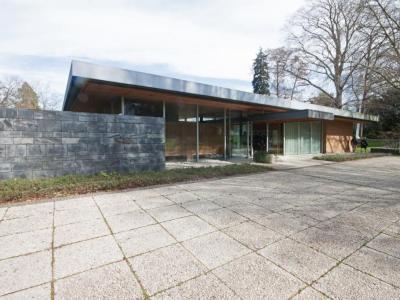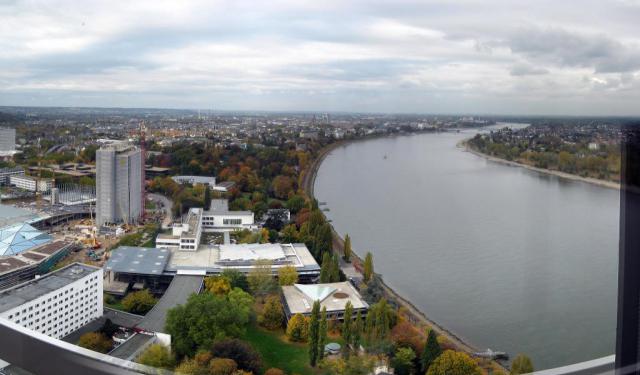
Kanzlerbungalow, Bonn
The former residential and reception building of the German Chancellor in Bonn is known as the Kanzlerbungalow. It was used for this purpose from 1964 to 1999. The bungalow is located in the park between the former Federal Chancellery (today's Federal Ministry for Economic Cooperation and Development) and the Palais Schaumburg, the Federal Chancellor's official residence in Bonn. It stands roughly on the site of the former Villa Selve, which was demolished in 1955.
The building is considered an important example of 1960s architecture with traditions dating back to the 1920s and has been a listed building since 2001. It is also a stop on the Democracy Trail.
The later Federal Chancellor Ludwig Erhard commissioned the residence as a symbol of the cosmopolitan and modern attitude of the Federal Republic of Germany while still in his function as Economics Minister. His predecessor, Konrad Adenauer, came to Bonn every day from his private home in Rhöndorf. The architect Sep Ruf, who was a friend of Erhard and had already built his private house, was commissioned in 1963 to construct a representative and modern building in the tradition of classical modernism in the park of the then Federal Chancellery, the Palais Schaumburg. The construction (approx. 1963-1966) is considered an outstanding example of West German post-war architecture. The construction costs amounted to around two million German marks.
The larger square is reserved for representation functions. In addition to the entrance and reception hall, it has a study, a large reception room, a dining room, the kitchen and a family dining room, which leads to the living and sleeping area.
The spatial construction is variable and allows perspectives. Sliding and lowering walls make flexible room combinations possible. For example, a music room and a fireplace hall can be separated.
The chancellor's and wife's bedrooms in the living square are mirror images and each have a dressing room, work area, bedroom and bathroom. They extend in a U-shape around the sleeping atrium with swimming pool. There are also three servants' rooms with a kitchenette, two guest rooms, a private living room and the staff lounge at the transition to the kitchen.
As part of the tightened security measures during the threat from the RAF, a bulletproof glass front was placed in front of the terrace in 1977; this should ward off a possible shelling from the right bank of the Rhine. In 1983/84, an additional basement was built outside the bungalow to store interchangeable furniture.
The building is considered an important example of 1960s architecture with traditions dating back to the 1920s and has been a listed building since 2001. It is also a stop on the Democracy Trail.
The later Federal Chancellor Ludwig Erhard commissioned the residence as a symbol of the cosmopolitan and modern attitude of the Federal Republic of Germany while still in his function as Economics Minister. His predecessor, Konrad Adenauer, came to Bonn every day from his private home in Rhöndorf. The architect Sep Ruf, who was a friend of Erhard and had already built his private house, was commissioned in 1963 to construct a representative and modern building in the tradition of classical modernism in the park of the then Federal Chancellery, the Palais Schaumburg. The construction (approx. 1963-1966) is considered an outstanding example of West German post-war architecture. The construction costs amounted to around two million German marks.
The larger square is reserved for representation functions. In addition to the entrance and reception hall, it has a study, a large reception room, a dining room, the kitchen and a family dining room, which leads to the living and sleeping area.
The spatial construction is variable and allows perspectives. Sliding and lowering walls make flexible room combinations possible. For example, a music room and a fireplace hall can be separated.
The chancellor's and wife's bedrooms in the living square are mirror images and each have a dressing room, work area, bedroom and bathroom. They extend in a U-shape around the sleeping atrium with swimming pool. There are also three servants' rooms with a kitchenette, two guest rooms, a private living room and the staff lounge at the transition to the kitchen.
As part of the tightened security measures during the threat from the RAF, a bulletproof glass front was placed in front of the terrace in 1977; this should ward off a possible shelling from the right bank of the Rhine. In 1983/84, an additional basement was built outside the bungalow to store interchangeable furniture.
Sight description based on Wikipedia.
Want to visit this sight? Check out these Self-Guided Walking Tours in Bonn. Alternatively, you can download the mobile app "GPSmyCity: Walks in 1K+ Cities" from Apple App Store or Google Play Store. The app turns your mobile device to a personal tour guide and it works offline, so no data plan is needed when traveling abroad.
Kanzlerbungalow on Map
Sight Name: Kanzlerbungalow
Sight Location: Bonn, Germany (See walking tours in Bonn)
Sight Type: Attraction/Landmark
Sight Location: Bonn, Germany (See walking tours in Bonn)
Sight Type: Attraction/Landmark
Walking Tours in Bonn, Germany
Create Your Own Walk in Bonn
Creating your own self-guided walk in Bonn is easy and fun. Choose the city attractions that you want to see and a walk route map will be created just for you. You can even set your hotel as the start point of the walk.
Bonn Introduction Walking Tour
In 12 BC or thereabouts, the Roman army established in the Rhine valley, a large military encampment called "Castra Bonnensis." Literally "Fort Bonn." Built of wood at first and then replaced by stone, the fort lasted well into the 5th century AD.
The old fort materials were used to build Bonn's 13th century walls. The medieval city formed around the Romanesque church... view more
Tour Duration: 1 Hour(s)
Travel Distance: 2.4 Km or 1.5 Miles
The old fort materials were used to build Bonn's 13th century walls. The medieval city formed around the Romanesque church... view more
Tour Duration: 1 Hour(s)
Travel Distance: 2.4 Km or 1.5 Miles
Beethoven Trail
One of the most recognized music geniuses, whose works remain mainstays of the classical music repertoire around the world, Ludwig van Beethoven saw the light of day in Bonn in 1770. Needless to say that the legacy of the city’s most famous resident is highly respected and honored today. Indeed, Beethoven's presence is still very much felt throughout Bonn, encountering visitors in many... view more
Tour Duration: 1 Hour(s)
Travel Distance: 1.5 Km or 0.9 Miles
Tour Duration: 1 Hour(s)
Travel Distance: 1.5 Km or 0.9 Miles


